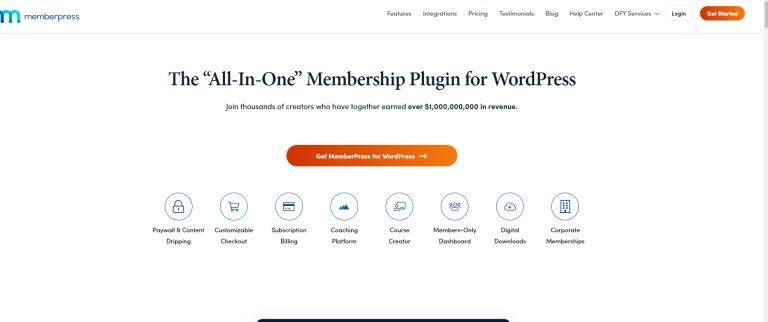12 Best Membership Site Platform Options for 2025

I spend a lot of time digging into the tools that help creators like us build amazing online communities and courses. Picking the right membership site platform can feel like a huge decision, because it is! It’s the foundation of your entire digital business.
You’re looking for a partner that can handle your payments, deliver your awesome content, and give your members a place to connect and thrive. Get this choice right, and everything feels smooth and professional. Get it wrong, and you’re stuck dealing with tech headaches instead of focusing on what you love.
I’ve been there, and I’ve tested a ton of these platforms. That’s exactly why I put together this comprehensive list. We’re going to walk through 12 of the very best options out there for 2025.
I’ll break down who each one is really for, what they do best, and where they might fall short. We’ll cover everything from all-in-one powerhouses like Kajabi to flexible WordPress plugins like MemberPress.
My goal is to give you the real-world insights, complete with screenshots and direct links, to make a choice you feel completely confident about. Let’s find the best membership site platform for you.
1. Kajabi
Kajabi stands out as a true all-in-one solution for creators who want to avoid the headache of stitching together multiple tools. It’s designed to be the central hub for your entire digital business. It combines your membership site, online courses, community, website, marketing funnels, and email automation into a single, cohesive dashboard.
This unified approach makes it a strong contender for the title of best membership site platform, especially if simplicity and power are your top priorities.
The platform lets you build everything from scratch or use its extensive library of templates (called “Blueprints”) to launch quickly. The real magic happens with its automation features.
For example, you can create a rule that automatically grants a customer access to a bonus course after they complete their first month in your membership, all without any manual work. This seamless integration is what sets Kajabi apart from piecing together a WordPress site with various plugins.

Key Details & Pricing
- Best For: Solo creators and small teams who want a powerful, integrated system and are willing to pay a premium for convenience and to avoid technical hurdles.
- Unique Feature: “Pipelines” (on Growth and Pro plans) which are pre-built marketing funnels that connect landing pages, email sequences, and offers to automate sales.
- Pricing: Starts at $149/month for the Basic plan, with Growth at $199/month and Pro at $399/month. They do not charge a platform transaction fee, which is a significant plus.
Pros & Cons
| Pros | Cons |
|---|---|
| Truly all-in-one: Simplifies your tech stack significantly. | High Price Point: It’s one of the more expensive options. |
| 0% Transaction Fees: You keep more of your revenue. | Usage Limits: Plans have limits on products and contacts. |
| Scalable: Grows with you from a solo operation to a larger team. | Less Customization: Not as flexible as a self-hosted option. |
Learn more at kajabi.com
2. Teachable
Teachable has long been a favorite for course creators, and it has evolved into a formidable membership site platform, especially for those prioritizing education. It excels at creating a streamlined learning experience for your members.
This allows you to package online courses, coaching services, digital downloads, and communities into a single subscription. The platform is designed to make both creating content and consuming it as simple as possible.
Where Teachable shines is in its focus on the student journey. You can build structured learning paths within your membership, drip content over time, and engage members through its integrated community features.
This makes it an excellent choice if your membership revolves around a core curriculum or a progressive learning model. It handles all the backend complexities like global payments and taxes, letting you focus on teaching your audience.

Key Details & Pricing
- Best For: Creators and educators whose memberships are centered around structured courses and a clear learning path.
- Unique Feature: A dedicated iOS app for students, allowing your members to access content on the go, which enhances the user experience.
- Pricing: Starts with a Free plan (10% transaction fee). Paid plans are Basic at $59/month (7.5% fee), Pro at $159/month (no fee), and Pro+ at $249/month (no fee).
Pros & Cons
| Pros | Cons |
|---|---|
| Excellent student experience: Clean, intuitive, and mobile-friendly. | Transaction fees on lower tiers: Fees can add up on the Free and Basic plans. |
| Simple product packaging: Easy to bundle courses and downloads. | Advanced features locked: Marketing tools require higher-tier subscriptions. |
| Handles global payments/taxes: Simplifies international sales. | Less of an all-in-one: Lacks native email marketing or advanced funnels. |
Learn more at teachable.com
3. Thinkific
Thinkific is a creator-first platform that shines when it comes to building vibrant learning communities alongside courses and memberships.
While many platforms focus solely on content delivery, Thinkific emphasizes student engagement. It provides robust tools to create a space where your members can connect, learn together, and grow.
This focus on community makes it a strong contender for the best membership site platform if you want to build more than just a content library. You’re building a home for your audience.
The platform makes it easy to bundle courses, offer payment plans, and manage your members all from one dashboard. I particularly appreciate its clear plan progression. This lets you start simple and add more powerful features like API access and advanced integrations as your business scales.
The ability to create unlimited courses on all paid plans is also a massive advantage. It gives you the freedom to experiment and expand your offerings without worrying about hitting a content ceiling.

Key Details & Pricing
- Best For: Course creators and educators who want to foster an active community around their content and need strong analytics to track student progress.
- Unique Feature: The Thinkific App Store allows for powerful one-click integrations with tools like Mailchimp, Stripe, and Zapier, extending the platform’s functionality.
- Pricing: Starts with a Free plan. Paid plans are Basic at $49/month, Start at $99/month, and Grow at $199/month. They also offer enterprise-level plans.
Pros & Cons
| Pros | Cons |
|---|---|
| Unlimited courses on all paid plans offer great value. | Community features are limited on lower-tier plans. |
| Strong analytics provide deep insights into student engagement. | Advanced integrations like SSO require higher-priced plans. |
| Clear plan progression that scales with your business needs. | No built-in email marketing, requires a third-party integration. |
Learn more at thinkific.com
4. Podia
Podia positions itself as the friendly, affordable all-in-one platform for creators who want to get started without a steep learning curve or high costs. It bundles memberships, online courses, digital downloads, communities, and even webinars into a single, clean interface. This approach makes it a fantastic choice for the best membership site platform if you value simplicity and want to launch quickly.
The platform is designed to be incredibly straightforward. You can build your entire storefront, create your membership plans, and upload content in just a few hours.
A standout feature is its generous “unlimited everything” policy on paid plans. This means you don’t have to worry about hitting caps on products or students. For creators just starting out, this removes a major barrier to growth and experimentation.

Key Details & Pricing
- Best For: New creators, solopreneurs, and anyone on a budget who needs an easy-to-use platform without complex features.
- Unique Feature: Its incredibly simple and transparent pricing structure, which includes a free plan and unlimited products on all paid plans.
- Pricing: Starts with a Free plan (with an 8% transaction fee). Paid plans are Mover at $39/month (5% fee) and Shaker at $89/month (0% fee). An optional Email add-on is available.
Pros & Cons
| Pros | Cons |
|---|---|
| Simple and transparent pricing: Easy to understand your costs. | Transaction fees on lower plans: The 5% fee on Mover can add up. |
| User-friendly interface: Very easy to learn and navigate. | Email is a paid add-on: Becomes an extra cost above 100 subscribers. |
| Free migrations: They’ll move your content for you on paid plans. | Less powerful automation: Lacks the advanced rules of competitors. |
Learn more at podia.com
5. Mighty Networks
Mighty Networks flips the traditional model on its head by putting community at the very center of the experience. Where other platforms add community as a feature, Mighty Networks builds everything around member interaction. This makes it an excellent choice for creators who want to foster deep engagement and a sense of belonging.
It’s designed to bring your courses, live events, chat, and content feeds together into one dynamic, interactive space. It feels more like a private social network than a static content library.
This community-first approach makes it one of the best membership site platform options for those who prioritize peer-to-peer connection.
You can create different “Spaces” within your network to house courses, mastermind groups, live cohort-based challenges, or simple discussion forums. Members get a native mobile app experience right away.
This allows them to engage with your community and content on the go, which is a massive advantage for retention.

Key Details & Pricing
- Best For: Community-led businesses, coaches, and creators who want to build an active, engaged network and offer courses and events within that ecosystem.
- Unique Feature: The ability to upgrade to your own fully white-labeled mobile app on iOS and Android via their Mighty Pro plan, creating a premium, branded experience.
- Pricing: The Community Plan is $49/month, the Courses Plan is $119/month, and the Business Plan is $219/month. Mighty Pro is custom-priced. Note that transaction fees apply on all plans except for Mighty Pro.
Pros & Cons
| Pros | Cons |
|---|---|
| Excellent community tools: Built for engagement and interaction. | Transaction fees: Plans charge a percentage on top of Stripe/PayPal. |
| Native mobile app included: Members can access on the go. | High cost for full branding: The white-label app is a premium add-on. |
| Flexible “Spaces” structure: Organizes content and groups well. | Less focus on marketing funnels: Not as robust as all-in-one platforms. |
Learn more at mightynetworks.com
6. Circle
Circle has carved out a niche as the go-to platform for creators who want to build a thriving, modern community at the heart of their business.
It excels at bringing discussions, live streams, events, courses, and paid memberships into one clean, intuitive space. Unlike platforms that treat community as an add-on, Circle makes it the main event. This makes it an excellent choice if engagement is your primary goal.
The platform is designed to feel less like a clunky forum and more like a private social network for your members. You can create different “spaces” for various topics, host live Q&As directly within the community, and sell access through flexible membership tiers.
For those looking to scale, Circle’s workflows and API access on higher-tier plans allow for powerful automations. You could, for example, trigger an email sequence when a member joins a specific space. This makes it a strong contender for the best membership site platform for community-centric brands.
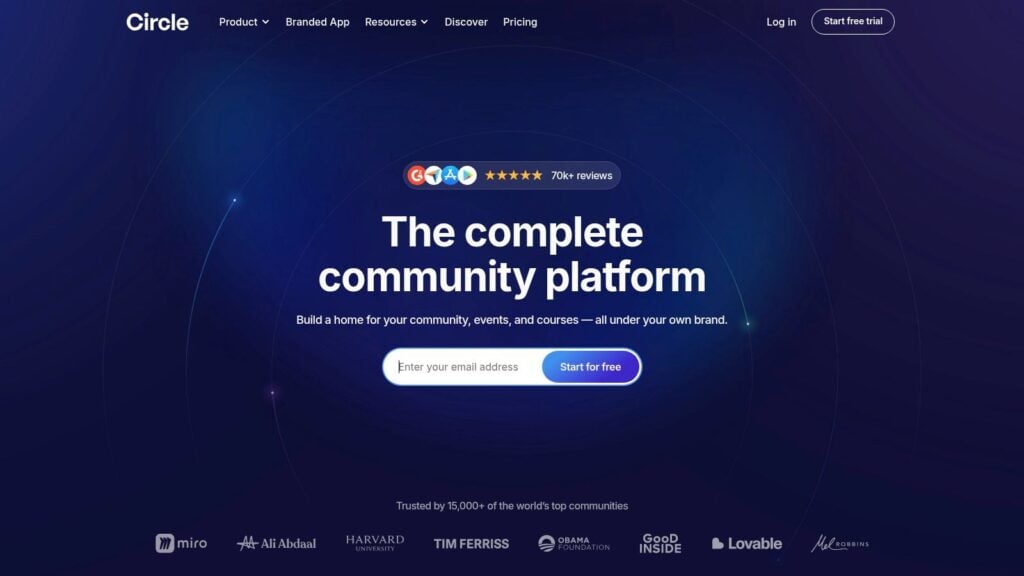
Key Details & Pricing
- Best For: Creators, coaches, and brands who prioritize building an active, engaged community alongside their courses and content.
- Unique Feature: Its deep focus on community-building tools, including dedicated spaces for discussions, live events, and direct messaging, all within a sleek interface.
- Pricing: Starts with a Basic plan at $49/month, Professional at $99/month, and Business at $219/month. Transaction fees apply on the Basic (4%) and Pro (2%) plans.
Pros & Cons
| Pros | Cons |
|---|---|
| Superior community experience: Modern, clean, and intuitive. | Transaction fees: Lower-tier plans include platform fees. |
| Flexible content structure: Mix courses, events, and forums. | Advanced features are gated: Workflows and API access cost more. |
| Integrates well with other tools: Connects easily via Zapier. | Not an all-in-one: Lacks built-in email marketing or funnels. |
Learn more at circle.so
7. MemberPress (WordPress plugin)
For those who already have a WordPress site or want complete control over their platform, MemberPress is a top-tier choice.
It’s a robust plugin that transforms a standard WordPress installation into a full-featured membership machine. Instead of being an all-in-one hosted solution, it gives you the power to gate content, create tiered subscription plans, and manage members directly within your own ecosystem. This makes it an incredibly powerful and flexible option for building the best membership site platform on your own terms.
The real strength of MemberPress lies in its granular control. You can protect almost any content with just a few clicks.
This includes pages, posts, categories, tags, and even individual files. It also includes powerful content dripping rules, allowing you to release lessons or modules over time to keep members engaged.
Because it’s a WordPress plugin, it integrates seamlessly with thousands of other tools. This gives you endless customization possibilities without being locked into a single provider’s system.

Key Details & Pricing
- Best For: WordPress users who want total ownership and control over their site’s functionality and are comfortable managing their own hosting and technical setup.
- Unique Feature: “Corporate Accounts” (on Plus and Pro plans) allow you to sell group memberships that a single manager can control, which is perfect for B2B training.
- Pricing: Starts at $179.50/year for the Basic license, with Plus at $299.50/year and Pro at $399.50/year. There are no transaction fees.
Pros & Cons
| Pros | Cons |
|---|---|
| Full ownership: You control your data and site with no platform fees. | Requires WordPress: You must manage your own hosting and updates. |
| Wide integrations: Connects with countless email and payment tools. | Steeper learning curve: More hands-on setup than all-in-ones. |
| Highly customizable: You can tailor the experience to your exact needs. | Advanced features cost more: Key tools are in higher-tier plans. |
Learn more about MemberPress
8. WooCommerce (Membership extensions)
For businesses already running on WordPress and WooCommerce, adding a membership component doesn’t have to mean migrating to a whole new system.
By using official extensions like WooCommerce Memberships and Subscriptions, you can build a deeply integrated experience directly within your existing e-commerce store. This approach is perfect for merchants who want to offer exclusive products, member-only pricing, or drip content to paying subscribers.
This setup transforms your store into a powerful membership hub. You can restrict access to specific products, pages, or posts based on a customer’s membership level. The real strength is how it leverages your existing product catalog.
For example, you could create a “VIP Club” that gives members a 10% discount on all purchases, automatically applied at checkout. This makes it a fantastic choice for a highly customizable membership site platform.

Key Details & Pricing
- Best For: Existing WordPress and WooCommerce store owners who want to add a membership component without leaving their current ecosystem.
- Unique Feature: The ability to tie memberships directly to product purchases, creating a seamless connection between your store and your content.
- Pricing: Extensions are sold as one-time annual licenses. WooCommerce Memberships is $199/year, and WooCommerce Subscriptions is $249/year. Both come with a 30-day money-back guarantee.
Pros & Cons
| Pros | Cons |
|---|---|
| Highly customizable: Leverages the full power of WordPress. | Self-Managed: You handle hosting, security, and updates. |
| Integrates with existing store: Works natively with your products. | Can get expensive: Multiple extensions may be needed for full features. |
| One-time annual license: Predictable, straightforward pricing model. | Steeper learning curve: Requires more technical know-how. |
Learn more at woocommerce.com
9. Squarespace Member Areas / Digital Products
For those already using Squarespace for their website, the Member Areas add-on is a beautifully integrated way to gate content and sell memberships. It avoids the complexity of third-party plugins by building the functionality directly into the Squarespace ecosystem you already know.
This makes it a natural choice if you love Squarespace’s design-forward approach and want to add a members-only section without migrating to a new platform.
The system allows you to protect specific pages, create different membership tiers, and sell access through one-time payments or recurring subscriptions.
You can easily manage members, view analytics, and offer promotions directly from your main Squarespace dashboard. It’s a simple, elegant solution for adding a revenue stream to an existing site, turning your portfolio or blog into a fully-fledged business hub.

Key Details & Pricing
- Best For: Current Squarespace users like artists, designers, and consultants who want to add a simple, stylish membership component without leaving the platform.
- Unique Feature: The complete design integration. Your member areas will perfectly match your existing site’s branding and aesthetic with zero code.
- Pricing: Member Areas is an add-on to a standard Squarespace plan. The add-on pricing starts at $10/month (plus 7% transaction fee) and goes up to $49/month (with a 1% transaction fee). This is in addition to your website subscription. For more info, you can learn more about setting up a membership site with Squarespace.
Pros & Cons
| Pros | Cons |
|---|---|
| Seamless integration: Works perfectly with existing Squarespace sites. | Transaction fees: Lower-tier plans have higher fees. |
| Beautiful, design-forward templates: No coding skills needed. | Add-on cost: It’s an extra monthly fee on top of your site plan. |
| Simple user interface: Easy to set up and manage. | Limited advanced features: Lacks the automation of all-in-ones. |
Learn more at squarespace.com
10. Wix Members Area + Pricing Plans
For those already invested in the Wix ecosystem, adding membership functionality doesn’t require migrating to a new platform. Wix’s built-in tools, specifically the free Members Area app combined with the Wix Pricing Plans app, provide a surprisingly capable solution.
This pairing allows you to gate access to specific pages, blog posts, online courses, and even booking services, creating a members-only experience directly on your existing Wix site.
The system works by letting you create different membership tiers or subscription plans. You can then assign specific permissions to each plan, controlling exactly what content or services each member can access.
Because it’s a native solution, it integrates seamlessly with other Wix features like Wix Stores, Events, and Groups. This makes it a great choice for business owners who want to add a recurring revenue stream without a major technical overhaul.
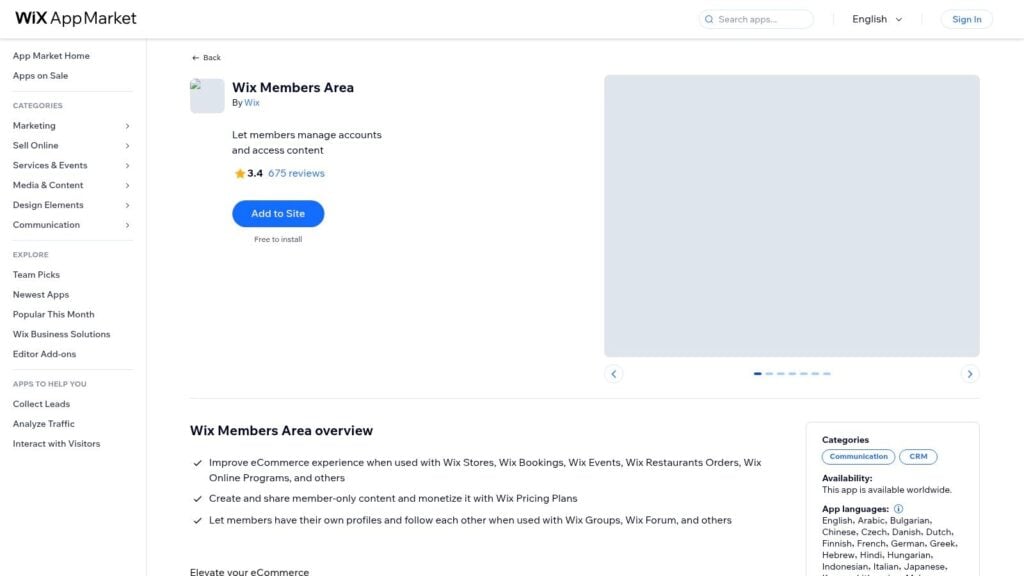
Key Details & Pricing
- Best For: Existing Wix users, such as bloggers, coaches, and small business owners, who want to add a simple membership component to their site without leaving the platform.
- Unique Feature: The deep integration with Wix’s broad app ecosystem (Bookings, Stores, Events, etc.), allowing you to sell memberships that grant access to a wide variety of services.
- Pricing: The Members Area app is free. Monetization requires a Wix Business & eCommerce plan (starting at $27/month) to accept online payments. Transaction fees vary based on your payment processor.
Pros & Cons
| Pros | Cons |
|---|---|
| Low barrier to entry for Wix users: It’s a native, familiar environment. | Can get complex: Advanced setups may require multiple Wix apps. |
| Broad app ecosystem: Integrates smoothly with other Wix tools. | Less flexible for heavy customization: Not as open as a WordPress setup. |
| All-in-one Wix dashboard: Manage your website and members in one place. | Tied to the Wix platform: You can’t migrate your membership easily. |
Learn more about how to create a Wix membership site
11. Patreon
Patreon is less of a traditional membership site builder and more of a creator-centric monetization platform. It’s built for artists, podcasters, musicians, and video creators who want a simple way to get recurring support from their biggest fans.
Instead of building a complex site, you create tiered membership levels where “patrons” pay a monthly or annual fee to access exclusive content, behind-the-scenes updates, and direct interaction with you.
The platform excels at ease of use. You can launch a page and start accepting payments in minutes, making it incredibly accessible for creators who aren’t technical.
Patreon handles all the complexities of payments, content delivery, and community management through a simple feed-style interface. This makes it a great choice for creators who already have an audience on other platforms like YouTube or Instagram and need a straightforward way to monetize that following without a lot of setup.

Key Details & Pricing
- Best For: Independent creators like artists, podcasters, and YouTubers who want a simple, audience-funded model without the overhead of building a full website.
- Unique Feature: Its strong network effect and built-in discovery tools. Fans already on Patreon are more likely to find and support new creators on the platform.
- Pricing: Pro plan is 8% of processed income, and the Premium plan is 12% for more advanced features like dedicated support and team accounts. Payment processing fees are separate.
Pros & Cons
| Pros | Cons |
|---|---|
| Extremely easy to set up: You can launch in under an hour. | Limited Customization: Your page looks like every other page. |
| Audience-focused: Built entirely around creator-fan relationships. | High Transaction Fees: Platform fees can add up over time. |
| Brand Recognition: Most fans already know and trust Patreon. | Less Control: You are building on rented land, not your own site. |
Learn more at patreon.com
12. Ghost(Pro)
Ghost(Pro) offers a refreshing, content-first approach for creators who want to build a newsletter-driven membership.
It’s a managed hosting service for the open-source Ghost CMS, taking care of the technical side while you focus on writing. This platform is built around the idea of direct audience relationships. It combines a blog, newsletter, and paid subscriptions into one sleek, minimalist interface.
It’s an ideal choice if your primary goal is publishing premium content rather than building complex courses.
The system’s native membership tools are seamlessly integrated. You can lock specific posts for free subscribers or paying members, send out different newsletters to various audience segments, and connect directly to Stripe for payments.
Unlike many all-in-one platforms, Ghost(Pro) feels like a professional-grade publishing tool that also happens to be a fantastic membership site platform. This appeals to writers and journalists who value content ownership and a clean user experience above all else.
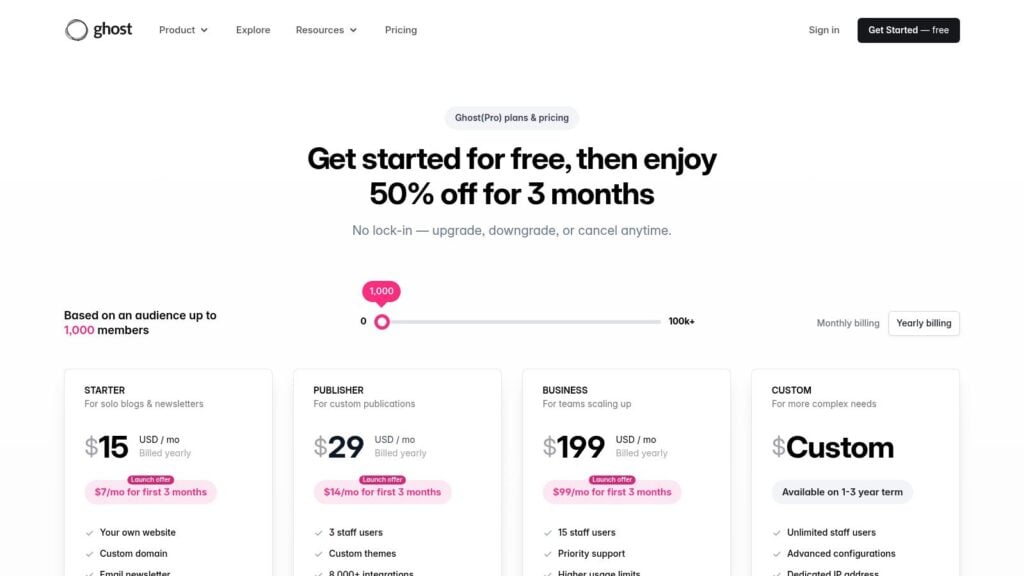
Key Details & Pricing
- Best For: Writers, journalists, and publishers who want a simple yet powerful platform for a newsletter-based paid community.
- Unique Feature: A transparent pricing slider that adjusts based on your exact number of members, so you only pay for what you use.
- Pricing: The Creator plan starts at $25/month for up to 500 members. Prices scale with your audience size. It boasts 0% platform transaction fees, you only pay standard Stripe processing fees.
Pros & Cons
| Pros | Cons |
|---|---|
| Fast, writer-first UX: A joy to use for content creation. | Limited Marketing Automation: Lacks built-in funnels or advanced tools. |
| 0% Transaction Fees: You keep all your revenue minus Stripe fees. | Fewer Integrations: Not as connected as a WordPress or Kajabi ecosystem. |
| Excellent for newsletters: Native tools for growing a subscriber base. | Not for complex courses: Best suited for premium content, not video courses. |
Learn more at ghost.org
Top 12 Membership Platforms Comparison
| Platform | Core Features | Value Proposition | Target Audience | Price & Fees |
|---|---|---|---|---|
| Kajabi | Memberships, courses, communities, email, website, automations | All-in-one, scalable, no platform fees | Creators scaling from solo to teams | Higher price, no platform transaction fees |
| Teachable | Courses, memberships, communities, global payments | Simple packaging, improved student UX | Educators focused on course delivery | Reduced transaction fees, 7.5% on Starter |
| Thinkific | Unlimited courses, memberships, payment plans, app marketplace | Robust analytics and integrations | Growing course creators | Free plan, advanced features require upgrades |
| Podia | Websites, memberships, courses, webinars, email optional | Budget-friendly, no platform fees (Shaker) | Budget-conscious creators | 5% fees on basic, no fees on Shaker plan |
| Mighty Networks | Courses, challenges, chat, events, livestreams | Community-first, strong engagement | Community-focused creators | Transaction fees on many plans, top tiers needed for branded apps |
| Circle | Discussions, events, courses, workflows, APIs | Flexible membership models | Creators balancing community & courses | Transaction fees on lower plans, workflows on upper tiers |
| MemberPress (WP Plugin) | Content gating, drip, subscriptions, quizzes | WordPress plugin with wide integrations | WordPress users wanting full control | One-time license, requires self-hosting |
| Woo Commerce (WP Extensions) | Membership plans, product restrictions, recurring billing | Native WooCommerce solution | WooCommerce store owners | Annual license, extensions may add cost |
| Squarespace Member Areas | Memberships, cohorts, courses, digital products | Seamless for Squarespace users | Squarespace site owners | Added cost plus transaction fees on lower tiers |
| Wix Members Area + Pricing | Member profiles, gated pages, roles, CRM | Easy start for Wix users | Wix website owners | Part of Wix ecosystem, some apps needed for features |
| Patreon | Paid tiers, gated content, media hosting, live chats | Audience-first membership platform | Creators seeking fan monetization | Platform fees up to 10% starting Aug 2025 |
| Ghost(Pro) | Memberships, newsletters, Stripe payments | Content ownership, newsletter-based | Publishers, writers | Transparent pricing, no platform fees (Stripe fees apply) |
So, What’s the Best Choice for You?
Whew, that was a lot of information to take in. We’ve explored everything from comprehensive, all-in-one solutions to focused community platforms and powerful WordPress plugins.
After reviewing all these options, one thing is crystal clear: there isn’t a single, one-size-fits-all winner for the title of best membership site platform.
The right choice for you hinges entirely on what you want to build, who you’re building it for, and your own personal workflow. What works for a solo course creator might not suit a large community. And what’s perfect for a WordPress expert could be a nightmare for a tech-averse entrepreneur.
Your Next Steps: How to Make a Final Decision
Instead of getting overwhelmed by feature lists, I want you to focus on your core business model. Your primary offer should guide your platform choice. Think about what your members will spend most of their time doing. Is it watching your video lessons, interacting in a forum, or reading your premium newsletter?
To narrow it down, here’s a quick-start guide based on common goals:
- For the “All-in-One” Entrepreneur: If you want a single platform to run your entire digital business and you have the budget for it, Kajabi is hard to beat. It handles courses, memberships, email marketing, and landing pages.
- For the “Community-First” Builder: If your main goal is to foster deep engagement and member-to-member connections, your top contenders are Mighty Networks and Circle. They are built from the ground up to prioritize interaction.
- For the “WordPress Power User”: If you already have a WordPress site and want maximum control, flexibility, and ownership, a plugin is your best bet. MemberPress offers robust, all-around membership functionality that integrates directly into your existing setup.
- For the “Budget-Conscious Beginner”: If you’re just starting out and need a simple, affordable, and user-friendly platform to sell your first digital products or a simple membership, Podia is an excellent and accessible starting point.
Don’t Forget to Test Drive
My final piece of advice is the most important one: take advantage of free trials. Reading reviews and comparing features is one thing, but actually using the software is another.
Sign up for a trial, click around the dashboard, upload a test video, and try to build a simple landing page. Imagine yourself working in that environment every day.
More importantly, imagine your members navigating it. Is it intuitive? Is it frustrating? This hands-on experience will tell you more than any article ever could.
Choosing your platform is a foundational step in building a successful and sustainable membership business. It’s a big decision, but it doesn’t have to be a scary one.


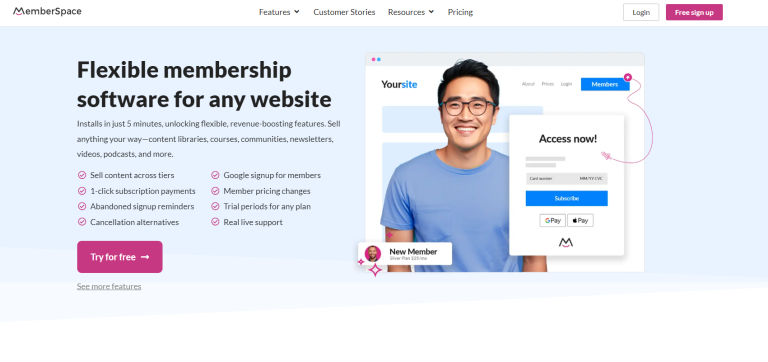
![How to Launch a Membership Site Using Squarespace [Step By Step Guide]](https://learnstream.io/wp-content/uploads/2024/11/image-768x433.png)

